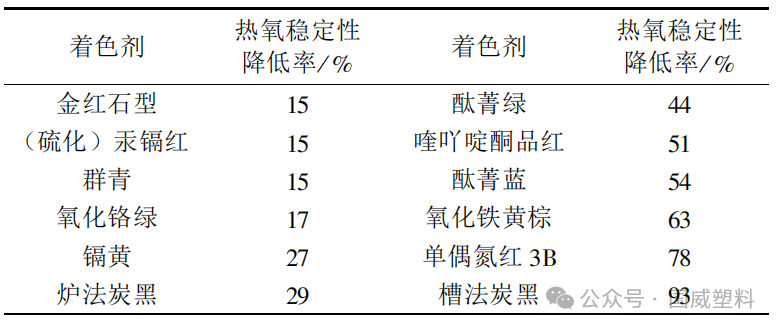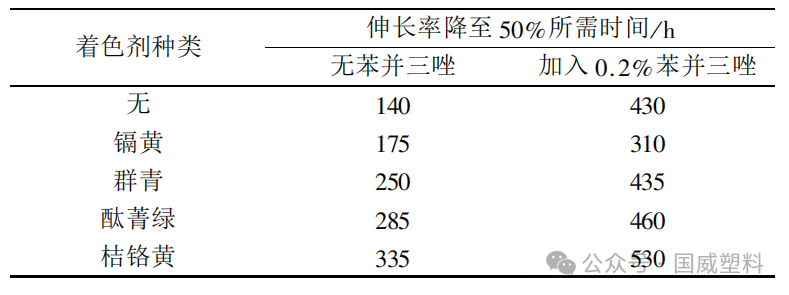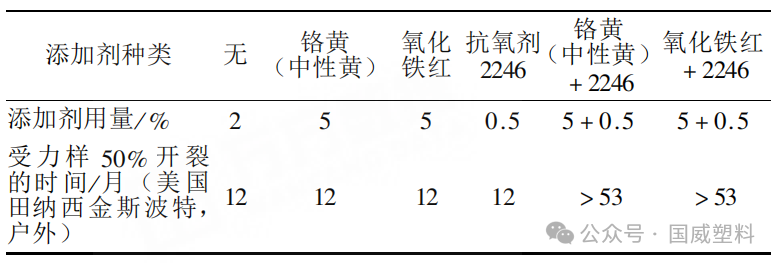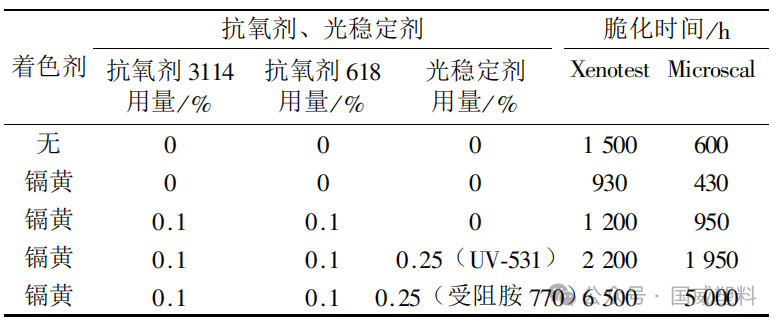Guide to Avoiding Pitfalls: How to Safely Combine Antioxidants and Light Stabilizers Amidst the Risks of Colorants?
If plastic colorants are improperly combined with antioxidants and light stabilizers, they can cause colored plastic products to fade or discolor prematurely, and also accelerate the photo-oxidative aging of the colored plastic products, resulting in deterioration of the appearance and physical mechanical properties of the products, causing them to lose their original functions and value ahead of time.
The Effect of Colorants on the Efficacy of Antioxidants and Light Stabilizers
The Effect of Colorants on the Efficacy of Antioxidants
Chrome yellow is an opaque inorganic pigment that can be used in thermoplastic plastics such as polyolefins, polystyrene, and acrylic resins. It has strong tinting strength, good hiding power, and excellent water and solvent resistance. However, because chrome yellow is a lead-containing compound composed of lead chromate or basic lead chromate and lead sulfate, it reacts chemically at the high temperatures of plastic processing when used with sulfur-containing antioxidants such as DLTP, DSTP, 1035, and 300. This reaction produces black lead sulfide, affecting the appearance of plastic products and significantly reducing the thermal oxidative aging resistance of the antioxidants. Therefore, chrome-containing pigments should not be used with sulfur-containing antioxidants.
In colored polypropylene, certain colorants can chemically react with low molecular weight hindered phenol antioxidants, thereby weakening the effectiveness of the antioxidants. Table 1 shows the effects of some colorants on the efficiency of low molecular weight phenolic antioxidants in polypropylene, which can be categorized into three types:
Table 1 | Effect of Colorants (0.5%) on the Thermal Oxidative Stability of Polypropylene Containing Phenolic Antioxidants

Severe impact: channel black, monoazo red 3B, quinacridone magenta, phthalocyanine blue, iron oxide yellow-brown.
Moderate impact: phthalocyanine green, furnace black, ultramarine, chromium oxide green;
Slightly affected: cadmium yellow, (sulfide) cadmium red, rutile type titanium dioxide.
Carbon black is a black pigment that can be used in various plastic materials and products, and it is the most widely used. It can also serve as a light stabilizer for plastic materials. Apart from its effect of weakening the efficacy of certain phenolic antioxidants in polypropylene, carbon black can also interact with the antioxidant BHT in low-density polyethylene, causing BHT to almost completely lose its effectiveness, while significantly reducing the light stabilizing effect of carbon black itself.
The outdoor exposure life of low-density polyethylene films containing 1% furnace black and 0.1% BHT is only about 40% of that of low-density polyethylene films containing 1% furnace black alone. For plastics such as polyethylene and polypropylene, when carbon black is selected as a coloring agent or light stabilizer, appropriate antioxidants must be used. Otherwise, not only will the effectiveness of antioxidants be reduced, but the outdoor light stability of the colored plastic products will also be compromised.
When titanium dioxide and pearlescent powder are used together with the phenolic antioxidant BHT in certain resins, they can cause white products to turn yellow, leading to quality issues.
The Influence of Colorants on the Effectiveness of Light Stabilizers
Colorants have two main effects on the performance of light stabilizers in colored plastic products.
Firstly, colorants containing heavy metal elements or impurities such as copper, manganese, and nickel possess photoactivity and photosensitivity, catalyzing and accelerating the photodegradation of plastic materials. Phthalocyanine blue containing free copper and impurities promotes the photodegradation of polypropylene; iron oxide red can reduce the effectiveness of benzotriazole, benzophenone, and organic nickel salt light stabilizers in polypropylene by more than 20%; for polyethylene, the use of colorants such as titanium dioxide, ultramarine, chromium oxide green, cobalt green, and iron red exacerbates photodegradation.
Second, certain colorants with specific molecular structures can interact with light stabilizers, directly diminishing the effectiveness of the stabilizers. Acidic colorants can render hindered amine light stabilizers ineffective; in polypropylene, azo red and yellow can react with hindered amine light stabilizers, while azo condensation red BR and azo condensation yellow 3G can reduce the effectiveness of hindered amine light stabilizers by approximately 25% and 50%, respectively.
Table 2 shows the effects of different pigments on the light stability of high-density polyethylene containing benzotriazole-type light stabilizer (UV-328). It can be seen from Table 2 that chrome orange significantly improves the light stability of high-density polyethylene, phthalocyanine green and ultramarine slightly improve or have little effect, while cadmium yellow reduces the light stability of high-density polyethylene.
Table 2 | Effects of Different Colorants on the Light Stability of High-Density Polyethylene Films Containing Benzotriazole

Steinlin F and Sear W used different colorants (1%), antioxidant 1010 (0.1%), light stabilizer 770 (0.5%), and polypropylene for spinning at 285°C, followed by fourfold drawing, to obtain fibers of 80 denier/24 filaments. The fibers were subjected to xenon lamp light exposure tests.
When the intensity decreases by 50%, the amount of radiation received by the samples is compared. The results indicate that polypropylene fibers colored with organic pigments yellow, red, and orange, although containing antioxidants and light stabilizers, exhibit lower stability than uncolored polypropylene fibers.
The role of antioxidants and light stabilizers in colored plastics
For colored plastic products, one of the roles of antioxidants and light stabilizers is to eliminate the destabilizing effect of colorants and protect the plastic resin. The second role is to protect the colorants by safeguarding the resin. The third role is to directly protect the colorants. For example, fluorescent pigments and other colorants are quite sensitive to ultraviolet light and have poor lightfastness, so benzophenone or benzotriazole UV absorbers need to be added for protection.
The function of antioxidants
Color masterbatch is a highly concentrated colored granular material made from colorants, carrier resins, dispersing agents, coupling agents, surfactants, and synergists. Using color masterbatch to produce colored plastic products is a widely adopted method in the plastic product manufacturing industry.
Generally speaking, the carrier resin used in the production of masterbatches has a lower molar mass and higher melt mass flow rate compared to the base resin used in the production of finished products. During the production of masterbatches, the carrier resin undergoes initial heating, and during the subsequent extrusion in the production of plastic products, the carrier resin first undergoes thermal and mechanical degradation, thereby accelerating the aging process of colored plastic products. Although the carrier resin in masterbatches constitutes a small proportion of colored plastic products, it has already undergone thermal oxidation due to being heated once or more times. Therefore, when producing masterbatches and using them to produce colored plastic products, antioxidants must be added.
Thermo-oxidative aging resistance is the basic anti-aging function of general plastic materials, while photo-oxidative aging resistance is an enhanced function built upon this foundation. To improve the light stability of colored plastic products, it is first necessary to enhance their thermo-oxidative stability. In some plastic products colored with ultraviolet-absorbing pigments, the addition of appropriate and adequate antioxidants can significantly increase the light stability of the products.
The data in Table 3 indicate that, in high-pressure polyethylene, the use of chrome yellow, iron oxide red, or antioxidant 2246 alone cannot improve the light stability of polyethylene.
Table 3 | Synergistic Effect of Antioxidants and UV-absorbing Pigments in High-density Polyethylene

When chromium yellow or iron oxide red is used together with antioxidant 2246, the light stability of high-pressure polyethylene is improved by more than three times. The essential role of antioxidant 2246 in this experiment is to enhance the thermal-oxidative stability of high-pressure polyethylene, and the objective manifestation or result is the improvement of the light stability of high-pressure polyethylene.
The function of light stabilizers
Ultraviolet (UV) absorbing light stabilizers, commonly known as UV absorbers, are classified into benzophenone and benzotriazole types based on their molecular structure. These light stabilizers utilize their own molecular structure to convert the light energy irradiated onto colored plastic products into thermal energy, preventing the molecular structure of the colorants (such as the conjugated double bond chromophores of organic colorants) from being damaged by light energy, and avoiding photo-oxidation reactions in the plastic materials. UV absorbers are light stabilizers that can directly protect the colorants and the appearance and color of colored plastic products.
Most colorants, especially inorganic pigment-type colorants, can provide a certain degree of light stability when used alone in plastic products. However, for colored plastic products intended for long-term outdoor use, it is not sufficient to rely solely on colorants to improve the light stability of the products. Only by using light stabilizers can the photoaging rate of colored plastic products be effectively and durably suppressed or slowed down, thereby significantly enhancing their light stability.
Hindered amine light stabilizers (HALS) are a class of organic amines with steric hindrance effects. Due to their abilities to decompose hydroperoxides, quench excited state oxygen, scavenge free radicals, and regenerate active groups cyclically, they exhibit high efficiency in preventing photodegradation and are the most widely used plastic light stabilizers both domestically and internationally.
Table 4 data indicate that appropriate light stabilizers or suitable combinations of antioxidants and light stabilizers can improve the light and oxygen stability performance of outdoor colored plastic products by several times. For plastic products colored with photoactive and photosensitive colorants (such as cadmium yellow and uncoated core-shell rutile), considering the catalytic photoaging effect of the colorants, the amount of light stabilizer added should be correspondingly increased.
Table 4 | Embrittlement Data of Recycled Polypropylene Pallet Box Materials

When producing colored plastic products, the selection of colorants, antioxidants, and light stabilizers, as well as the determination of their dosages, must take into account the influence of colorants on the effectiveness of antioxidants and light stabilizers. It is necessary to conduct tests to determine the impact and synergistic effects of using all three together on the color and anti-aging stability of the products.
For colorants, antioxidants, and light stabilizers formulations or combination systems determined through testing or practical application, when the base resin, processing technology and conditions, product shape, and usage environment of the colored plastic products remain unchanged, any slight variation in the type of antioxidant or light stabilizer, or in the color, type, dispersion, quality, or dosage of the colorant, may cause significant quality problems in the colored plastic products.
【Copyright and Disclaimer】The above information is collected and organized by PlastMatch. The copyright belongs to the original author. This article is reprinted for the purpose of providing more information, and it does not imply that PlastMatch endorses the views expressed in the article or guarantees its accuracy. If there are any errors in the source attribution or if your legitimate rights have been infringed, please contact us, and we will promptly correct or remove the content. If other media, websites, or individuals use the aforementioned content, they must clearly indicate the original source and origin of the work and assume legal responsibility on their own.
Most Popular
-

EVA Morning Prices on September 12: Most of the Market Holds Steady, Highest Rise of 50 Yuan
-

[PET Weekly Outlook] Polyester Bottle Chips Expected to Oscillate and Warm Up with Costs Today
-

List Released! Mexico Announces 50% Tariff On 1,371 China Product Categories
-

EU Changes ELV Regulation Again: Recycled Plastic Content Dispute and Exclusion of Bio-Based Plastics
-

Case Study | Clariant AddWorks™ Additives Solve Plastic Yellowing Problem






